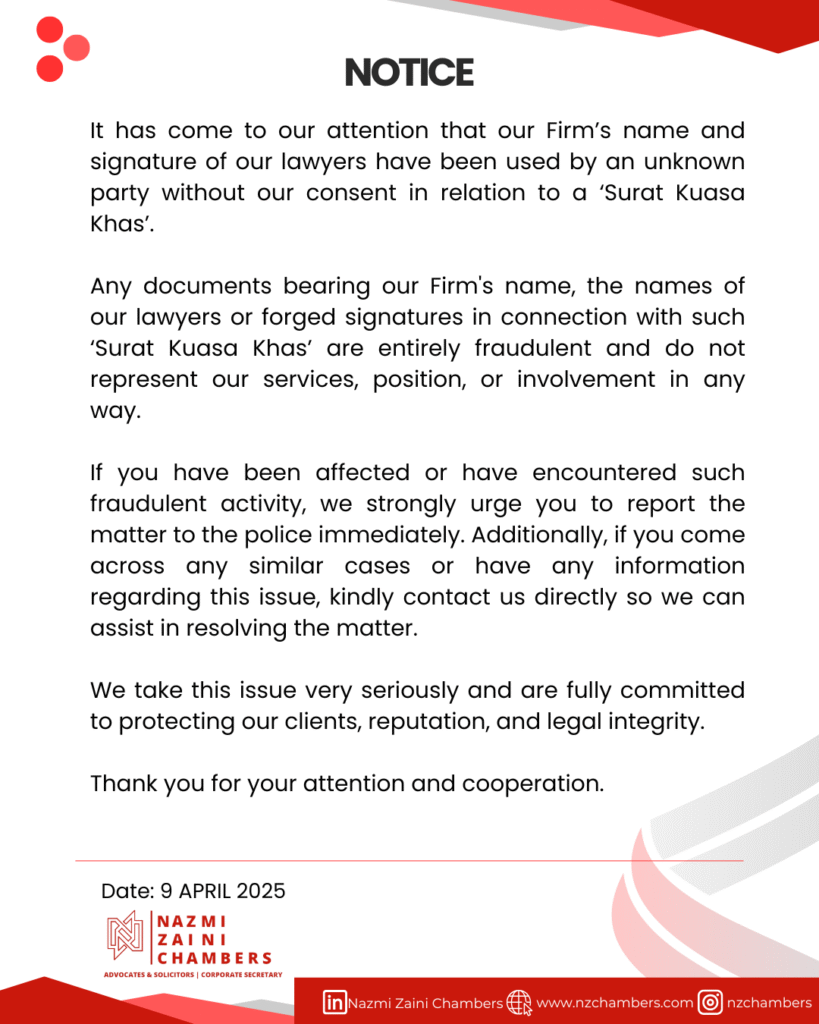INTEREST SCHEMES IN MALAYSIA
Interest schemes in Malaysia are regulated by the Interest Scheme Act 2016 (“ISA 2016”). Introduced alongside the new Companies Act 2016 (“CA 2016”), the ISA 2016 was originally under Division 5 of the preceding Companies Act 1965 and was introduced to provide a more comprehensive regulatory framework for interest schemes, recognising the need for detailed oversight of their establishment, business operations, and investor protection. As an alternative fundraising mechanism for companies, the ISA 2016 ensures these schemes operate with the necessary safeguards to protect investors while promoting responsible business practices.
WHAT CONSTITUTES AN INTEREST SCHEME
Under the ISA 2016, there are four (4) natures of schemes identified, which are:- (a) an investment scheme; (b) a recreational membership scheme; (c) a time-sharing scheme; or (d) a combination of such schemes.[1] In this article, we will dissect specifically on the more common type of scheme, i.e. the investment scheme.
In an investment scheme, an interest holder does not have direct control over the day-to-day operations of the scheme, even if they have the right to be consulted or provide input. These schemes involve participants contributing money or assets to gain a right or interest in the profits, assets, or financial benefits of a business or financial venture. The contributions may be pooled together in a common enterprise, where the participants expect to earn returns such as profits, rent, or interest primarily through the efforts of the scheme’s promoter or a third party.[2]
This investment scheme concept closely aligns with the principles set out in the landmark case of Securities and Exchange Commission v. W.J. Howey Co.[3], which establishes the Howey test. This test is used to determine whether an instrument or transaction qualifies as an “investment contract” for the purposes of the US Securities Act. The US Supreme Court, in the case, defines an investment contract as “a contract, transaction or scheme whereby a person invests his money in a common enterprise and is led to expect profits solely from the efforts of the promoter or a third party”. It is further clarified that it is immaterial whether these shares are evidenced by formal certificates or by nominal interests in the physical assets involved.
The Howey Test, which focuses on whether there is an investment of money in a common enterprise with profits expected to come solely from the efforts of others, has become an important principle in evaluating the nature of investment schemes. If this test is satisfied, the enterprise is considered an investment contract, regardless of whether the underlying venture is speculative or non-speculative, or involves the sale of property with or without intrinsic value.
Similarly, in Malaysia, the concept applies to interest schemes, where investors provide capital and expect returns from a collective effort. These schemes, often structured as passive investments, include a variety of industries such as property development and agricultural ventures.
TYPES OF INTEREST SCHEMES
Under Section 5 of the ISA 2016, a scheme may be registered as a premium scheme, a small scheme or a foreign scheme. The specific requirements for each type of scheme under the ISA 2016 are outlined in the table below:-
| Type of Scheme | Type of Company | Minimum Paid Up Capital (RM) | Fund Size (RM) | Other Requirement(s) |
| Premium Scheme | Company Limited by Shares under Companies Act 2016 | · 1 Million
|
· Above 10 Million to 50 Million | specifies in its constitution that the management of interest scheme is one of its main objects |
| · 2 Million | · Above 50 Million to 100 Million | |||
| Small Scheme | Public Company limited by Shares under Companies Act 2016 | 500,000.00 | Minimum of 1 Million and Maximum of 10 Million | specifies in its constitution that the management of interest scheme is one of its main objects |
| Foreign Scheme | Public Company Limited by Shares by its origin country | · 5 Million | · Above 100 Million | · specifies in its constitution that the management of interest scheme is one of its main objects; and
· the scheme has been authorized or recognized by the regulatory authority in its origin country to offer or propose interests to the public |
| · 5 Million | · Any Amount |
REGISTRATION OF AN INTEREST SCHEME
Upon determining the type of interest scheme, a company would be required to register the interest scheme which involves a meticulous process to ensure compliance with regulatory standards and transparency for potential investors.
1. Preparing the Prelodgment Form[4] and Fees
The initial step involves preparing the Prelodgment Form, which includes all essential details about the scheme. This form must be submitted to the Companies Commission of Malaysia (CCM) along with the required fees. The fees vary depending on the nature and size of the scheme[5].
2. Drafting the Trust Deed or Contractual Agreement
A crucial document in this process is the Trust Deed or Contractual Agreement. This document outlines the terms and conditions of the scheme, ensuring that it complies with legal standards. It should include comprehensive details about the rights and obligations of the participants and the management of the scheme’s assets.
3. Creating a Prospectus or Product Disclosure Statement
The prospectus or product disclosure statement is vital as it provides potential participants with detailed information about the scheme. This document should include the scheme’s objectives, risks, financial projections, and other relevant details. It must be clear, accurate, and comply with regulatory standards to avoid any misleading information.
4. Submission to the Companies Commission of Malaysia
Once the Prelodgment Form, Trust Deed/Contractual Agreement, and Prospectus/Product Disclosure Statement are prepared, they must be submitted to the CCM. Depending on the CCM’s specific requirements, this submission process may also require additional documentation.
5. Obtaining Approval from CCM
After submission, the CCM will review all the documents to ensure compliance with regulatory standards. This review process may take some time, and during this period, the CCM may request additional information or clarifications. Depending on its nature, the scheme may also need approval from the Minister.
6. Registering the Scheme with CCM
Upon obtaining approval from the CCM, the next step is to register the scheme officially. This involves submitting any final documents and paying the registration fees. Successfully registering the scheme with the CCM is a critical milestone, as it provides legal recognition and authorization to operate the scheme.
7. Issuance of the Certificate of Registration
Once the scheme is registered, the CCM will issue a certificate of registration. This certificate serves as official documentation that the scheme has met all regulatory requirements and is authorized to operate.
CAUTIONS ON MISLEADING PROSPECTUS
Investors rely on prospectuses to make informed decisions about where to put their money. These documents are meant to provide a clear and accurate picture of a company’s financial health and future prospects. However, when prospectuses are misleading—whether through omissions, false statements, or cleverly presented half-truths—they can lead to disastrous consequences for both investors and companies.
A misleading prospectus not only undermines investor trust but also exposes the company and its directors to severe legal repercussions. Cases like Rex v Kyslant[6]and Public Prosecutor v Mok Chin Fan & Ors[7] serve as stark reminders of the importance of full transparency and honesty in financial disclosures. These landmark cases highlight how even technically true statements can be criminally misleading if they create a false overall impression.
REX V KYSLANT
The 1932 case of Rex v Kyslant marked a significant evolution in corporate law, especially in the context of securities regulation and companies’ obligations towards their investors. This case set crucial legal precedents concerning the disclosure of financial information and the liabilities arising from misleading statements.
Facts of the Case
In 1928, the Royal Mail Steam Packet Company, one of the world’s foremost shipping organizations, sought to raise £2 million through the issuance of debenture stock. The prospectus issued to potential investors emphasized the company’s historical financial success, stating that over the past decade, it had made sufficient profits to cover interest debts more than five times and had consistently paid dividends to ordinary shareholders for 17 years.
However, the prospectus failed to mention that the company had operated at a loss for seven of those years and had depleted substantial reserves accumulated during more prosperous times to maintain dividend payments. This omission painted an overly optimistic picture of the company’s financial health, masking the underlying financial instability that only significant improvement could rectify.
Legal Proceedings and Decision
Lord Kyslant, the company’s chairman, was charged with knowingly publishing false information to mislead investors. The Court of Criminal Appeal upheld his conviction, establishing that presenting partial truths in a manner that creates a misleading impression constitutes criminal misrepresentation, even if individual statements are technically accurate.
The decision in this case reinforced principles from the earlier New Brunswick R v Muggereridge[8] case, solidifying the notion that misleading impressions can lead to legal liability. Justice Avory highlighted that even statements true in isolation could amount to misrepresentation if they create a deceptive overall picture. This judgment underscored that companies suggesting completeness in their disclosures must ensure full and accurate representation of their financial conditions.
Implications and Takeaways
The Rex v Kyslant case is pivotal in emphasizing the stringent standards companies must adhere to when handling public money. The ruling clarified that liability arises from falsely claiming a genuine opinion, including vague yet misleading statements.
Moreover, the case advanced the understanding that nuanced or clever defenses cannot absolve deliberate attempts to mislead investors. The legal framework became more robust, focusing on regulating the issuance of risky and unreliable securities and addressing the marketing and sale of these securities to investors.
PUBLIC PROSECUTOR V MOK CHIN FAN & ORS
The case of Public Prosecutor v Mok Chin Fan & Ors, decided by the Court of Appeal on 22 April 2015, is a landmark decision in Malaysian corporate law which echoes the principles established in the earlier case of R v Kyslant regarding the necessity of having an accurate prospectus. This case highlights the severe consequences of issuing misleading financial statements and underscores the importance of accuracy and integrity in corporate disclosures.
Facts of the Case
In this case, the first, second, and fourth respondents were directors of INIX Technologies Holdings Sdn Bhd, while the third respondent was responsible for the company’s financial matters. The company issued a prospectus claiming that 97.1% of its reported revenue was accurate. However, it was later discovered that 93.37% of the total sales reported in its quarterly financial reports were false.
The respondents had approved the issuance of the prospectus and authorized the submission of false financial statements to Bursa Malaysia upon the company’s listing. These actions significantly misrepresented the company’s financial health, misleading investors.
Legal Proceedings and Decisions
High Court Decision
All respondents were charged under Section 122B of the Securities Industry Act 1983 and Section 55 of the Securities Commission Act 1993. They pleaded guilty to the charges. The trial judge imposed fines totalling RM325,000 on the first and second respondents, RM350,000 on the third respondent, and RM1.1 million on the fourth respondent. Although the High Court upheld these sentences, the prosecution was dissatisfied and filed an appeal.
Court of Appeal Decision
The Court of Appeal found that the misleading prospectus transformed a loss of RM5.084 million into a profit of RM2.448 million, effectively implicating Bursa Malaysia in the fraud. The respondents showed no remorse and continued to maintain false figures to keep investors interested.
The Court of Appeal sentenced each respondent to six months in prison (nine months for the fourth respondent) and imposed additional fines. This decision served as a stern warning against similar offenses.
The key takeaway from this case includes:
- Severe Consequences for Misleading Statements: Companies and their directors can face significant penalties, including imprisonment and substantial fines, for issuing misleading financial statements.
- Importance of Transparency: Accurate and truthful financial disclosures are crucial to maintain investor trust and market integrity.
- No Defense in Nuanced Misleading: Even technically true statements can result in liability if they collectively create a misleading picture.
LIABILITY FOR MISLEADING PROSPECTUS
Under the ISA 2016, strict penalties are imposed on management companies and their officers for issuing or authorizing false or misleading statements in any prospectus, financial report, or required document. If a company knowingly publishes false or misleading information, or intentionally omits crucial details that mislead investors, it faces fines of up to RM3 million.
Officers involved in such misconduct can face even more severe consequences, including up to 10 years in prison, fines up to RM3 million, or both[9]. This applies not only to those who directly make or approve false statements but also to anyone who knowingly votes in favor of publishing such information. The law emphasizes the importance of transparency and accountability, ensuring that companies are held liable for any deception that could harm investors.
The severity of these penalties underscores the critical responsibility management companies and their officers bear in providing accurate, clear, and honest information to the public.
CONCLUSION
Interest schemes in Malaysia provide a structured and transparent way for companies to raise funds while protecting investor interests. By adhering to the regulatory framework and ensuring transparency and compliance, companies can successfully register and operate their schemes, gaining the trust of potential investors. This comprehensive approach not only fosters a responsible business environment but also enhances investor confidence in the financial markets.
Authors:
- Aryn Rozali
- Maryam Amilah Zaini
- Wan Tasnima
References:
[1] Section 4(1) of the Interest Scheme Act 2016
[2] Section 4(2) of the Interest Scheme Act 2016
[3] 328 U.S. 293 (1946)
[4] https://www.ssm.com.my/Documents/register_business_company/company/prelodgement_form_iss_9.1.18.pdf
[5] Regulation 9, Interest Scheme Regulations 2017
[6] [1932] AC 510
[7] [2015] 6 MLJ 857
[8] 62 E.R. 263
[9] Section 82 of the Interest Scheme Act 2016






